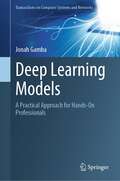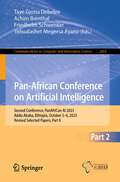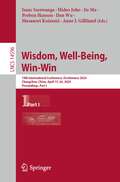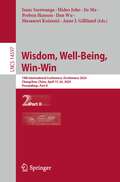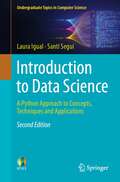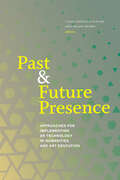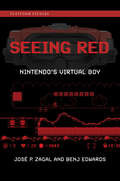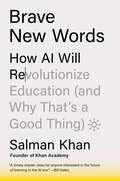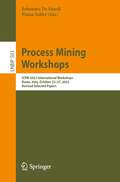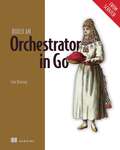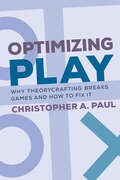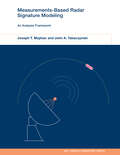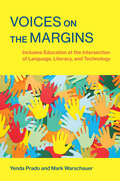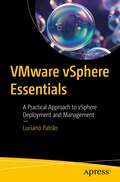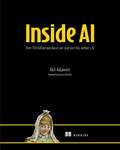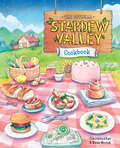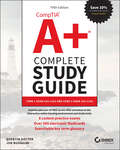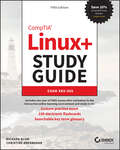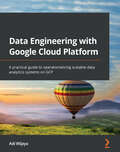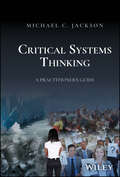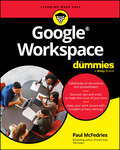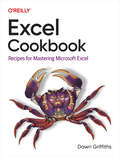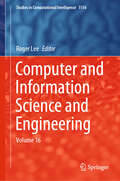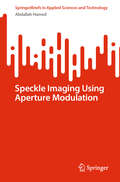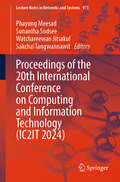- Table View
- List View
Deep Learning Models: A Practical Approach for Hands-On Professionals (Transactions on Computer Systems and Networks)
by Jonah GambaThis book focuses on and prioritizes a practical approach, minimizing theoretical concepts to deliver algorithms effectively. With deep learning emerging as a vibrant field of research and development in numerous industrial applications, there is a pressing need for accessible resources that provide comprehensive examples and quick guidance. Unfortunately, many existing books on the market tend to emphasize theoretical aspects, leaving newcomers scrambling for practical guidance. This book takes a different approach by focusing on practicality while keeping theoretical concepts to a necessary minimum. The book begins by laying a foundation of basic information on deep learning, gradually delving into the subject matter to explain and illustrate the limitations of existing algorithms. A dedicated chapter is allocated to evaluating the performance of multiple algorithms on specific datasets, highlighting techniques and strategies that can address real-world challenges when deep learning is employed. By consolidating all necessary information into a single resource, readers can bypass the hassle of scouring scattered online sources, gaining a one-stop solution to dive into deep learning for object detection and classification. To facilitate understanding, the book employs a rich array of illustrations, figures, tables, and code snippets. Comprehensive code examples are provided, empowering readers to grasp concepts quickly and develop practical solutions. The book covers essential methods and tools, ensuring a complete and comprehensive coverage that enables professionals to implement deep learning algorithms swiftly and effectively.This book is designed to equip professionals with the necessary skills to thrive in the active field of deep learning, where it has the potential to revolutionize traditional problem-solving approaches. This book serves as a practical companion, enabling readers to grasp concepts swiftly and embark on building practical solutions.
Pan-African Conference on Artificial Intelligence: Second Conference, PanAfriCon AI 2023, Addis Ababa, Ethiopia, October 5–6, 2023, Revised Selected Papers, Part II (Communications in Computer and Information Science #2069)
by Taye Girma Debelee Achim Ibenthal Friedhelm Schwenker Yehualashet Megersa AyanoThis two-volume set, CCIS 2068 and 2069, constitutes selected papers presented during the Second Pan-African Conference on Artificial Intelligence, PanAfriCon AI 2023, held in Addis Ababa, Ethiopia, in October 2023. The set goal of the conference is to exchange the best practices of joint Pan-African efforts to provide solutions for Africa’s key 21st century challenges in the social, economic and ecologic domains. The 29 papers were thoroughly reviewed and selected from 134 submissions. The papers are organized in the following topical sections: Medical AI; Natural Language Processing, Text and Speech Processing; AI in Finance and Cyber Security; Autonomous Vehicles; AI Ethics and Life Sciences.
Wisdom, Well-Being, Win-Win: 19th International Conference, iConference 2024, Changchun, China, April 15–26, 2024, Proceedings, Part I (Lecture Notes in Computer Science #14596)
by Isaac Sserwanga Hideo Joho Jie Ma Preben Hansen Dan Wu Masanori Koizumi Anne J. GillilandThe Three-volume set LNCS 14596, 14596 and 14598 constitutes the proceedings of the 19th International Conference on Wisdom, Well-Being, Win-Win, iConference 2024, which was hosted virtually by University of Tsukuba, Japan and in presence by Jilin University, Changchun, China, during April 15–26, 2024. The 36 full papers and 55 short papers are presented in these proceedings were carefully reviewed and selected from 218 submissions. The papers are organized in the following topical sections: Volume I: Archives and Information Sustainability; Behavioural Research; AI and Machine Learning; Information Science and Data Science; Information and Digital Literacy. Volume II: Digital Humanities; Intellectual Property Issues; Social Media and Digital Networks; Disinformation and Misinformation; Libraries, Bibliometrics and Metadata. Volume III: Knowledge Management; Information Science Education; Information Governance and Ethics; Health Informatics; Human-AI Collaboration; Information Retrieval; Community Informatics; Scholarly, Communication and Open Access.
Wisdom, Well-Being, Win-Win: 19th International Conference, iConference 2024, Changchun, China, April 15–26, 2024, Proceedings, Part II (Lecture Notes in Computer Science #14597)
by Isaac Sserwanga Hideo Joho Jie Ma Preben Hansen Dan Wu Masanori Koizumi Anne J. GillilandThe Three-volume set LNCS 14596, 14596 and 14598 constitutes the proceedings of the 19th International Conference on Wisdom, Well-Being, Win-Win, iConference 2024, which was hosted virtually by University of Tsukuba, Japan and in presence by Jilin University, Changchun, China, during April 15–26, 2024. The 36 full papers and 55 short papers are presented in these proceedings were carefully reviewed and selected from 218 submissions. The papers are organized in the following topical sections: Volume I: Archives and Information Sustainability; Behavioural Research; AI and Machine Learning; Information Science and Data Science; Information and Digital Literacy. Volume II: Digital Humanities; Intellectual Property Issues; Social Media and Digital Networks; Disinformation and Misinformation; Libraries, Bibliometrics and Metadata. Volume III: Knowledge Management; Information Science Education; Information Governance and Ethics; Health Informatics; Human-AI Collaboration; Information Retrieval; Community Informatics; Scholarly, Communication and Open Access.
Introduction to Data Science: A Python Approach to Concepts, Techniques and Applications (Undergraduate Topics in Computer Science)
by Laura Igual Santi SeguíThis accessible and classroom-tested textbook/reference presents an introduction to the fundamentals of the interdisciplinary field of data science. The coverage spans key concepts from statistics, machine/deep learning and responsible data science, useful techniques for network analysis and natural language processing, and practical applications of data science such as recommender systems or sentiment analysis. Topics and features: Provides numerous practical case studies using real-world data throughout the book Supports understanding through hands-on experience of solving data science problems using Python Describes concepts, techniques and tools for statistical analysis, machine learning, graph analysis, natural language processing, deep learning and responsible data scienceReviews a range of applications of data science, including recommender systems and sentiment analysis of text data Provides supplementary code resources and data at an associated website This practically-focused textbook provides an ideal introduction to the field for upper-tier undergraduate and beginning graduate students from computer science, mathematics, statistics, and other technical disciplines. The work is also eminently suitable for professionals on continuous education short courses, and to researchers following self-study courses.
Past and Future Presence: Approaches for Implementing XR Technology in Humanities and Art Education
by Lissa Crofton-Sleigh Brian BeamsWhile uses and studies of XR technology within STEM-based education have been plentiful in recent years, there has been lesser or even, at times, a lack of coverage for this novel learning tool in the arts and humanities.Past and Future Presence aims to bridge some of that gap by presenting research-based theory and case studies of successful application and implementation of XR technology into postsecondary educational settings, ranging in topics from ancient to modern languages, classical and contemporary art, and reenvisioned historical scenes and events presented in ways never seen before. The studies also contemplate how this novel medium can enhance and supplement learning in classrooms and other formal or informal learning environments. The volume as a whole is intended to demonstrate to educators, scholars, and researchers in higher education the potential value of integrating XR technology into their classrooms and to provide a strong argument for college and university administrators to invest in training and development of new research and content for classrooms inside and outside of STEM. The authors of these chapters come from a diverse range of backgrounds at different stages of their careers, providing a broad crosssection of scholastic work within the humanities and arts. Each chapter offers a different angle or approach to incorporating XR technology into teaching or research within different subject areas. As the volume suggests, this technology also places additional emphasis on the humanity within the humanities, by focusing on increasing connection between users and different cultures, time periods, and perspectives.
Seeing Red: Nintendo's Virtual Boy (Platform Studies)
by Jose P. Zagal Benj EdwardsThe curious history, technology, and technocultural context of Nintendo&’s short-lived stereoscopic gaming console, the Virtual Boy.With glowing red stereoscopic 3D graphics, the Virtual Boy cast a prophetic hue: Shortly after its release in 1995, Nintendo's balance sheet for the product was "in the red" as well. Of all the innovative long shots the game industry has witnessed over the years, perhaps the most infamous and least understood was the Virtual Boy. Why the Virtual Boy failed, and where it succeeded, are questions that video game experts José Zagal and Benj Edwards explore in Seeing Red, but even more interesting to the authors is what the platform actually was: what it promised, how it worked, and where it fit into the story of gaming.Nintendo released the Virtual Boy as a standalone table-top device in 1995—and quickly discontinued it after lackluster sales and a lukewarm critical reception. In Seeing Red, Zagal and Edwards examine the device's technical capabilities, its games, and the cultural context in the US in the 1990s when Nintendo developed and released the unusual console. The Virtual Boy, in their account, built upon and extended an often-forgotten historical tradition of immersive layered dioramas going back 100 years that was largely unexplored in video games at the time. The authors also show how the platform's library of games conveyed a distinct visual aesthetic style that has not been significantly explored since the Virtual Boy's release, having been superseded by polygonal 3D graphics. The platform's meaning, they contend, lies as much in its design and technical capabilities and affordances as it does in an audience's perception of those capabilities. Offering rare insight into how we think about video game platforms, Seeing Red illustrates where perception and context come, quite literally, into play.
Brave New Words: How AI Will Revolutionize Education (and Why That's a Good Thing)
by Salman Khan&“A timely masterclass for anyone interested in the future of learning in the AI era.&”—Bill Gates&“This book is required reading for everyone who cares about education.&”—Adam Grant, #1 New York Times bestselling author of Hidden Potential and Think Again, and host of the podcast Re:Thinking&“Read this book. It&’s the most fascinating and important account of how AI will transform the way we learn.&”—Walter Isaacson, #1 New York Times bestselling authorFrom the founder of Khan Academy, the first book on the AI revolution in education, its implications for parenting, and how we can best harness its power for good.Whether we like it or not, the AI revolution is coming to education. In Brave New Words, Salman Khan, the visionary behind Khan Academy, explores how artificial intelligence and GPT technology will transform learning, and offers a road map for teachers, parents, and students to navigate this exciting (and sometimes intimidating) new world.A pioneer in the field of education technology, Khan examines the ins and outs of these cutting-edge tools and how they will revolutionize the way we learn and teach. For parents concerned about their children&’s success, Khan illustrates how AI can personalize learning by adapting to each student&’s individual pace and style, identifying strengths and areas for improvement, and offering tailored support and feedback to complement traditional classroom instruction. Khan emphasizes that embracing AI in education is not about replacing human interaction but enhancing it with customized and accessible learning tools that encourage creative problem-solving skills and prepare students for an increasingly digital world.But Brave New Words is not just about technology—it&’s about what this technology means for our society, and the practical implications for administrators, guidance counselors, and hiring managers who can harness the power of AI in education and the workplace. Khan also delves into the ethical and social implications of AI and large language models, offering thoughtful insights into how we can use these tools to build a more accessible education system for students around the world.
Process Mining Workshops: ICPM 2023 International Workshops, Rome, Italy, October 23–27, 2023, Revised Selected Papers (Lecture Notes in Business Information Processing #503)
by Johannes De Smedt Pnina SofferThis volume constitutes the revised selected papers of several workshops which were held in conjunction with the 5th International Conference on Process Mining, ICPM 2023, held in Rome, Italy, in October 23–27, 2023.The 38 revised full papers presented in this book were carefully reviewed and selected from 85 submissions. The book also contains one invited talk. ICPM 2023 presented the following six workshops:– 4th International Workshop on Event Data and Behavioral Analytics (EdbA)– 4th International Workshop on Leveraging Machine Learning in Process Mining (ML4PM)– 6th International Workshop on Process-Oriented Data Science for Healthcare (PODS4H)– 8th International Workshop on Process Querying, Manipulation, and Intelligence (PQMI)– 2nd International Workshop on Education Meets Process Mining (EduPM)– 2nd International Workshop on Collaboration Mining for Distributed Systems (COMINDS).
Build an Orchestrator in Go (From Scratch)
by Tim BoringDevelop a deep understanding of Kubernetes and other orchestration systems by building your own with Go and the Docker API.Orchestration systems like Kubernetes can seem like a black box: you deploy to the cloud and it magically handles everything you need. That might seem perfect—until something goes wrong and you don&’t know how to find and fix your problems. Build an Orchestrator in Go (From Scratch) reveals the inner workings of orchestration frameworks by guiding you through creating your own. In Build an Orchestrator in Go (From Scratch) you will learn how to: Identify the components that make up any orchestration system Schedule containers on to worker nodes Start and stop containers using the Docker API Manage a cluster of worker nodes using a simple API Work with algorithms pioneered by Google&’s Borg Demystify orchestration systems like Kubernetes and Nomad Build an Orchestrator in Go (From Scratch) explains each stage of creating an orchestrator with diagrams, step-by-step instructions, and detailed Go code samples. Don&’t worry if you&’re not a Go expert. The book&’s code is optimized for simplicity and readability, and its key concepts are easy to implement in any language. You&’ll learn the foundational principles of these frameworks, and even how to manage your orchestrator with a command line interface. About the technology Orchestration frameworks like Kubernetes and Nomad radically simplify managing containerized applications. Building an orchestrator from the ground up gives you deep insight into deploying and scaling containers, clusters, pods, and other components of modern distributed systems. This book guides you step by step as you create your own orchestrator—from scratch. About the book Build an Orchestrator in Go (From Scratch) gives you an inside-out perspective on orchestration frameworks and the low-level operation of distributed containerized applications. It takes you on a fascinating journey building a simple-but-useful orchestrator using the Docker API and Go SDK. As you go, you&’ll get a guru-level understanding of Kubernetes, along with a pattern you can follow when you need to create your own custom orchestration solutions. What's inside Schedule containers on worker nodes Start and stop containers using the Docker API Manage a cluster of worker nodes using a simple API Work with algorithms pioneered by Google&’s Borg About the reader For software engineers, operations professionals, and SREs. This book&’s simple Go code is accessible to all programmers. About the author Tim Boring has 20+ years of experience in software engineering. For most of that time he has worked with orchestration systems, including Borg, Kubernetes, and Nomad. Table of Contents PART 1 INTRODUCTION 1 What is an orchestrator? 2 From mental model to skeleton code 3 Hanging some flesh on the task skeleton PART 2 WORKER 4 Workers of the Cube, unite! 5 An API for the worker 6 Metrics PART 3 MANAGER 7 The manager enters the room 8 An API for the manager 9 What could possibly go wrong? PART 4 REFACTORINGS 10 Implementing a more sophisticated scheduler 11 Implementing persistent storage for tasks PART 5 CLI 12 Building a command-line interface 13 Now what?
Optimizing Play: Why Theorycrafting Breaks Games and How to Fix It
by Christopher A. PaulAn unexpected take on how games work, what the stakes are for them, and how game designers can avoid the traps of optimization.The process of optimization in games seems like a good thing—who wouldn&’t want to find the most efficient way to play and win? As Christopher Paul argues in Optimizing Play, however, optimization can sometimes risk a tragedy of the commons, where actions that are good for individuals jeopardize the overall state of the game for everyone else. As he explains, players inadvertently limit play as they theorycraft, seeking optimal choices. The process of developing a meta, or the most effective tactic available, structures decision making, causing play to stagnate. A &“stale&” meta then creates a perception that a game is solved and may lead players to turn away from the game.Drawing on insights from game studies, rhetoric, the history of science, ecology, and game theory literature, Paul explores the problem of optimization in a range of video games, including Overwatch, FIFA/EA Sports FC, NBA 2K, Clash Royale, World of Warcraft, and League of Legends. He also pulls extensively from data analytics in sports, where the problem has progressed further and is even more intractable than it is in video games, given the money sports teams invest to find an edge. Finally, Paul offers concrete and specific suggestions for how games can be developed to avoid the trap set by optimization run amok.
Measurements-Based Radar Signature Modeling: An Analysis Framework (MIT Lincoln Laboratory Series)
by Joseph T. Mayhan John A. TabaczynskiA high-level text that synthesizes diverse research areas for characterizing objects (targets) from radar data and establishes a novel analysis framework for a class of signal processing techniques useful for high-resolution radar signature modeling.The only text to integrate a diverse body of work on characterizing objects (targets) from radar data into a common analysis framework, this book brings together the results of research papers and technical reports providing improved resolution and precision in radar target signature modeling and target motion solutions. It offers comprehensive coverage related to basic radar concepts, signal representation, and radar measurements; the development of advanced analysis tools essential for high-resolution signature modeling; the development of novel wideband and narrowband radar imaging techniques; the application of 2D spectral estimation theory to wideband signal processing; ultra-wideband scattering phenomenology and sparse-band sensor data fusion; and the integration of field measurements into the radar signature modeling process. The analysis techniques developed in the text provide the framework for a novel approach, called measurements-based modeling (MBM), to model target signatures by incorporating measurement data into the signature model of the target. Extensive examples throughout compare the performance of the new techniques with that of conventional analysis techniques.The first systematic, comprehensive synthesis of wide-ranging research areas for characterizing targets from radar data A deeply researched, lucid presentation enriched by extensive illustrations and examples An essential reference for experts in radar and signal processing, professional engineers in related fields, and graduate students
Voices on the Margins: Inclusive Education at the Intersection of Language, Literacy, and Technology
by Yenda Prado Mark WarschauerA rich view of inclusive education at the intersection of language, literacy, and technology—drawing on case study research in a diverse full-inclusion US school before, during, and after the COVID-19 pandemic.Despite advancing efforts at integration, the segregation of students with disabilities from their nondisabled peers persists. In the United States, 34 percent of all students with disabilities spend at least 20 percent of their instructional time in segregated classrooms. For students with intellectual or multiple disabilities, segregated placement soars to 80 percent. In Voices on the Margins, Yenda Prado and Mark Warschauer provide an ethnography of an extraordinary full-inclusion public charter school in the western United States—Future Visions Academy. And they ask: What does it mean to be inclusive in today&’s schools with their increasingly pervasive use of digital technologies?Voices on the Margins examines the ways digital technologies support inclusion and language and literacy practices for culturally and linguistically diverse children with and without disabilities. A wide range of qualitative data collected in the case study illuminates three central themes: (1) the kinds of social organization that allow a fully inclusive environment for children with disabilities to thrive, (2) the ways that digital technologies can be used to help students express their voice and agency, while developing language and literacy skills, and (3) the ways that digital technologies can be used to foster stronger networks and connections between students, teachers, staff, and parents.
VMware vSphere Essentials: A Practical Approach to vSphere Deployment and Management
by Luciano PatrãoThis book fills a vacuum in the market for high-quality information on a VMware vSphere system and offers a thorough introduction to VMware virtualization. Written for novices and those seeking more information about vSphere, this book walks you through its key concepts and technology, such as vSphere infrastructure creation, maintenance, and performance for beginners and advanced users.You'll take a step-by-step approach to guarantee you grasp the fundamental concepts and practical procedures required to construct and manage virtual machines in a VMware vSphere system. You'll explore the key components of vSphere with detail and explanation for each feature, including the hypervisor, networking, storage, and high availability, unravelling their intricacies and highlighting best practices.This book provides full VMware knowledge to develop, set up, and maintain vSphere environments that meet modern computing needs. It also features advanced topics, such as resource optimization, performance monitoring, advanced settings, and automation, empowering you to take your virtualization skills to the next level. VMware vSphere Essentials uses a unique step-by-step instructions designed to provide a high-level understanding, accompanied by illustrative images. What You'll LearnEnhance network efficiency with advanced vSphere LACP setupConfigure and manage virtual machines in vSphereImplement vSphere networking and storage Explore advanced vSphere features, such as DRS, HA, and fault toleranceMaster seamless VM migration techniquesOptimize hardware utilization with direct path I/O passthroughWho This Book Is ForSystem administrators, advanced vSphere administrators, and IT professionals pursuing VMware certifications
Inside AI: Over 150 billion purchases per year use this author's AI
by Akli AdjaouteSeparate the AI facts from the AI fiction, and discover how you can best put these tools to work in your organization.In Inside AI AI professor and entrepreneur Dr. Akli Adjaoute puts AI in perspective, with informed insights from 30 years spent in the field. His book lays out a pragmatic blueprint that every leader can utilize to drive innovation with artificial intelligence. In Inside AI you&’ll learn how to: Gain insight into diverse AI techniques and methodologies Learn from both successful and failed AI applications Identify the capabilities and limitations of AI systems Understand successful and failed uses of AI in business See where human cognition still exceeds AI Bust common myths like AI&’s threat to jobs and civilization Manage AI projects effectively Inside AI takes you on a journey through artificial intelligence, from AI&’s origins in traditional expert systems all the way to deep learning and Large Language Models. There&’s no hype here—you&’ll get the grounded, evidence-based insights that are vital for making strategic decisions and preparing your business for the future. About the technology Artificial Intelligence enthusiasts promise everything from human-like collaboration on everyday tasks to the end of work as we know it. Is AI just a flash in the pan, or can it really transform how you do business? This intriguing book sifts through the hype and separates the truth from the myths, with clear advice on what AI can—and can&’t—achieve. About the book Inside AI provides a clear-headed overview of modern artificial intelligence, including the recent advances of Generative AI and Large Language Models. Its accessible and jargon-free explanations of leading AI techniques showcase how AI delivers tangible advantages to businesses. Both inspiring and practical, this book provides a proven framework for developing successful AI applications. What's inside Insights from successful and failed AI applications A survey of AI techniques and methodologies Bust common AI myths Manage AI projects effectively About the reader For anyone seeking grounded insights into AI&’s capabilities, including business leaders and decision makers. About the author Akli Adjaoute is the founder of multiple AI-related companies. He served as an adjunct professor at the University of San Francisco and as Scientific Committee Chair and Head of the AI department at EPITA. The technical editor on this book was Richard Vaughan. Table of contents 1 The rise of machine intelligence 2 AI mastery: Essential techniques, Part 1 3 AI mastery: Essential techniques, Part 2 4 Smart agent technology 5 Generative AI and large language models 6 Human vs. machine 7 AI doesn&’t turn data into intelligence 8 AI doesn&’t threaten our jobs 9 Technological singularity is absurd 10 Learning from successful and failed applications of AI 11 Next-generation AI A Tracing the roots: From mechanical calculators to digital dreams B Algorithms and programming languages
The Official Stardew Valley Cookbook
by ConcernedApe Ryan NovakThe first official cookbook from the immensely popular Stardew Valley, featuring more than 50 delightful recipes straight out of the video game.&“Hungry? Thirsty? I&’ve got just the thing!&”—Gus Welcome to Stardew Valley, where each season brings a new crop of bountiful food to make for friends and family. From farm staples like veggies, fruit, milk, and eggs to foraged mushrooms and berries to fresh fish, there&’s always something delicious to put on the table. These 50 recipes are based on in-game meals and food, allowing you to cook and eat all your home-grown and fresh-caught ingredients in real life. The Official Stardew Valley Cookbook is organized by season and has recipes from your favorite characters, including the Queen of Sauce and Gus at the Stardrop Saloon. Written in collaboration with independent game creator ConcernedApe and packed with original illustrations and food photography, The Official Stardew Valley Cookbook helps you bring the Valley&’s incredible flavors to the dinner table, giving you the energy to take on the world.
CompTIA A+ Complete Study Guide: Core 1 Exam 220-1101 and Core 2 Exam 220-1102 (Sybex Study Guide)
by Quentin Docter Jon BuhagiarThe Fifth Edition of the CompTIA A+ Complete Study Guide: Core 1 Exam 220-1101 and Core 2 Exam 220-1102 offers accessible and essential test preparation material for the popular A+ certification. Providing full coverage of all A+ exam objectives and competencies covered on the latest Core 1 and Core 2 exams, the book ensures you'll have the skills and knowledge to confidently succeed on the test and in the field as a new or early-career computer technician. The book presents material on mobile devices, hardware, networking, virtualization and cloud computing, network, hardware, and software troubleshooting, operating systems, security, and operational procedures. Comprehensive discussions of all areas covered by the exams will give you a head start as you begin your career as a computer technician. This new edition also offers: Accessible and easy-to-follow organization perfect to prepare you for one of the most popular certification exams on the market today Opportunities to practice skills that are in extraordinary demand in the IT industry Access to the Sybex online test bank, with chapter review questions, full-length practice exams, hundreds of electronic flashcards, and a glossary of key terms, all supported by Wiley's support agents who are available 24x7 via email or live chat to assist with access and login questions Perfect for anyone prepping for the Core 1 and Core 2 A+ exams, CompTIA A+ Complete Study Guide: Core 1 Exam 220-1101 and Core 2 Exam 220-1102 is a must-have resource for new and early-career computer technicians seeking to improve their skills and increase their efficacy in the field. And save 10% when you purchase your CompTIA exam voucher with our exclusive WILEY10 coupon code.
CompTIA Linux+ Study Guide: Exam XK0-005 (Sybex Study Guide)
by Richard Blum Christine BresnahanThe best-selling, hands-on roadmap to acing the new Linux+ exam In the newly updated Fifth Edition of CompTIA Linux+ Study Guide: Exam XK0-005, IT industry veterans and tech education gurus Richard Blum and Christine Bresnahan deliver a concise and practical blueprint to success on the CompTIA Linux+ exam and in your first role as a Linux network or system administrator. In the book, you’ll find concrete strategies and proven techniques to master Linux system management, security, scripting, containers, automation, and troubleshooting. Every competency tested on the Linux+ exam is discussed here. You’ll also get: Hands-on Linux advice that ensures you’re job-ready on the first day of your new network or sysadmin role Test-taking tips and tactics that decrease exam anxiety and get you ready for the challenging Linux+ exam Complimentary access to the Sybex learning environment, complete with online test bank, bonus practice exams, electronic flashcards, and a searchable glossary Perfect for practicing network and system admins seeking an in-demand and valuable credential for working with Linux servers and computers, CompTIA Linux+ Study Guide: Exam XK0-005, Fifth Edition, will also earn a place in the libraries of people looking to change careers and start down an exciting new path in tech. And save 10% when you purchase your CompTIA exam voucher with our exclusive WILEY10 coupon code.
Data Engineering with Google Cloud Platform: A practical guide to operationalizing scalable data analytics systems on GCP
by Adi WijayaBuild and deploy your own data pipelines on GCP, make key architectural decisions, and gain the confidence to boost your career as a data engineerKey FeaturesUnderstand data engineering concepts, the role of a data engineer, and the benefits of using GCP for building your solutionLearn how to use the various GCP products to ingest, consume, and transform data and orchestrate pipelinesDiscover tips to prepare for and pass the Professional Data Engineer examBook DescriptionWith this book, you'll understand how the highly scalable Google Cloud Platform (GCP) enables data engineers to create end-to-end data pipelines right from storing and processing data and workflow orchestration to presenting data through visualization dashboards. Starting with a quick overview of the fundamental concepts of data engineering, you'll learn the various responsibilities of a data engineer and how GCP plays a vital role in fulfilling those responsibilities. As you progress through the chapters, you'll be able to leverage GCP products to build a sample data warehouse using Cloud Storage and BigQuery and a data lake using Dataproc. The book gradually takes you through operations such as data ingestion, data cleansing, transformation, and integrating data with other sources. You'll learn how to design IAM for data governance, deploy ML pipelines with the Vertex AI, leverage pre-built GCP models as a service, and visualize data with Google Data Studio to build compelling reports. Finally, you'll find tips on how to boost your career as a data engineer, take the Professional Data Engineer certification exam, and get ready to become an expert in data engineering with GCP. By the end of this data engineering book, you'll have developed the skills to perform core data engineering tasks and build efficient ETL data pipelines with GCP.What you will learnLoad data into BigQuery and materialize its output for downstream consumptionBuild data pipeline orchestration using Cloud ComposerDevelop Airflow jobs to orchestrate and automate a data warehouseBuild a Hadoop data lake, create ephemeral clusters, and run jobs on the Dataproc clusterLeverage Pub/Sub for messaging and ingestion for event-driven systemsUse Dataflow to perform ETL on streaming dataUnlock the power of your data with Data StudioCalculate the GCP cost estimation for your end-to-end data solutionsWho this book is forThis book is for data engineers, data analysts, and anyone looking to design and manage data processing pipelines using GCP. You'll find this book useful if you are preparing to take Google's Professional Data Engineer exam. Beginner-level understanding of data science, the Python programming language, and Linux commands is necessary. A basic understanding of data processing and cloud computing, in general, will help you make the most out of this book.
Critical Systems Thinking: A Practitioner's Guide
by Michael C. JacksonCRITICAL SYSTEMSTHINKING Understand the full range of systems approaches and how to use them with this innovative overview. Leaders and managers face increasing complexity and uncertainty because technical, organizational, socio-cultural, political, and environmental issues have become intensely interconnected. Systems thinking is recognized as the essential competence for managing complexity. As the demand for systems thinking grows, however, the fragmentation of the field into different methodologies has become a potential liability. Critical systems thinking (CST) shows how this diversity can be a strength rather than a weakness by revealing how different systems methodologies address various aspects of complexity and how they can be used in combination to resolve the messiest of wicked problems. Critical Systems Thinking offers, in a single volume, an account of the value of systems thinking and CST in the modern world, an explanation of the pragmatic philosophy and expansion in mindset necessary to embrace CST, and detailed instructions on how to undertake critical systems practice (CSP) using the variety of systems approaches to navigate multi-dimensional complexity. Readers will find: An accessible introduction to systems thinking and CST. A description and critique of the best-known systems methodologies. A guide to the mindset changes, the steps required, and the toolkit necessary to undertake successful CSP. Case studies and examples of CSP. A discussion of the nature of systemic leadership. Critical Systems Thinking is ideal for leaders and managers in government, business, the public sector, the professions, and beyond who want to understand the potential of systems thinking and use it in their work. It is essential for systems researchers and practitioners who want a deeper understanding of the field.
Google Workspace For Dummies
by Paul McFedriesEasy advice for getting the most out of Google Workspace for school, work, or personal use Google Workspace For Dummies is here to show you the tips and tricks for upping your productivity with Google's cloud-based software suite. This book includes jargon-free instructions on using Gmail, Calendar, Docs, Sheets, Drive, Chat, and Meet. You'll learn about the AI features, updated security, compatibility with other apps, picture-in-picture capability for video meetings, and beyond. Plus, you'll get info on Google's Forms and Notes feature that makes it simple to gather and share data and stay up-to-date with your team. It's easier than ever to collaborate securely in the cloud, thanks to this Dummies book. Learn how to collaborate with colleagues in real time using the programs that come with Google Workspace Create and edit contacts, and set up video meetings Work on slides, spreadsheets, and documents Discover tips and tricks to increase productivity and keep your work secure Google Workspace For Dummies is a must for business users and workers who use Google applications on the job. Casual users and students, you'll love it, too.
Excel Cookbook
by Dawn GriffithsFilled with tips, tricks, and techniques, this easy-to-use book is the perfect resource for intermediate to advanced users of Excel. You'll find complete recipes for more than a dozen topics covering formulas, PivotTables, charts, Power Query, and more. Each recipe poses a particular problem and outlines a solution that you can put to use right away—without having to comb through tutorial pages.Whether you're a data analyst, project manager, or financial analyst, author Dawn Griffiths directs you straight to the answers you need. Ideal as a quick reference, Excel Cookbook is also perfect for learning how to work in a more efficient way, leading to greater productivity on the job. With this book, you'll jump in and get answers to your questions—fast.This cookbook shows you how to:Get the most out of Excel's featuresAddress complex data problems in the best way possibleCollect, manage, and analyze data from a variety of sourcesUse functions and formulas with ease—including dynamic array and lambda formulasAnalyze data with PivotTables, Power Pivot, and moreImport and transform data with Power QueryWrite custom functions and automate Excel with VBA
Computer and Information Science and Engineering: Volume 16 (Studies in Computational Intelligence #1156)
by Roger LeeThis book reports state-of-the-art results in Computer Information Science and Engineering in both printed and electronic form. Studies in Computation Intelligence (SCI) has grown into the most comprehensive computational intelligence research forum available in the world.
Speckle Imaging Using Aperture Modulation (SpringerBriefs in Applied Sciences and Technology)
by Abdallah HamedThis book covers speckle image formation using a variety of modulated apertures. The central theme revolves around theoretical analyses, specifically the calculation of impulse responses or Point Spread Functions (PSFs) corresponding to these apertures. These calculations provide crucial insights into the resolution inherent in the resulting speckle images. The book begins with an examination of the recognition of the direction of new apertures from elongated speckle images, setting the stage for subsequent discussions. The theoretical analyses extend to diverse aperture designs, including Gaussian, graded-index, and modulated apertures. The book delves into the nuanced dynamics of contrast in speckle images, exploring the Voigt distribution and the effects of modulation on contrast. In addition to aperture-centric discussions, the book addresses the processing of the formed speckle images. The chapters impart a comprehensive understanding of speckle imaging, encompassing discrimination in microscopy using digital speckle images, the utilization of concentric hexagonal pupils, and the exploration of irregular apertures. The book culminates in a detailed exploration of speckle imaging in the context of an annular Hermite Gaussian laser beam. Overall, this book serves as a valuable resource for researchers and academics seeking a profound exploration of speckle image formation, modulation, and processing across a spectrum of apertures and theoretical frameworks.
Proceedings of the 20th International Conference on Computing and Information Technology (Lecture Notes in Networks and Systems #973)
by Phayung Meesad Sunantha Sodsee Watchareewan Jitsakul Sakchai TangwannawitThis book gathers the high-quality papers presented at the 20th International Conference on Computing and Information Technology (IC2IT2024), held on May 16-17, 2024, in Bangkok, Thailand. The book presents an original research work for both academic and industry domains, which is aiming to show valuable knowledge, skills and experiences in the field of computing and information technology. The topics covered in the book include natural language processing, image processing, intelligent systems and algorithms, as well as machine learning. These lead to the major research directions for innovating computational methods and applications of information technology.
